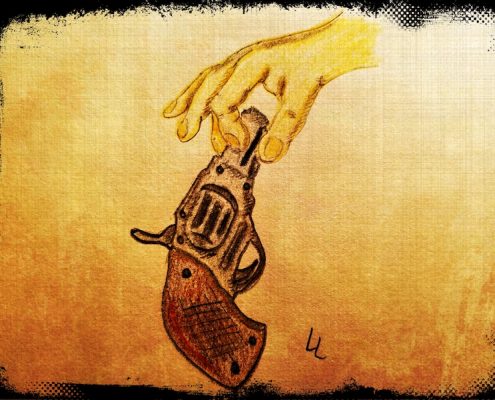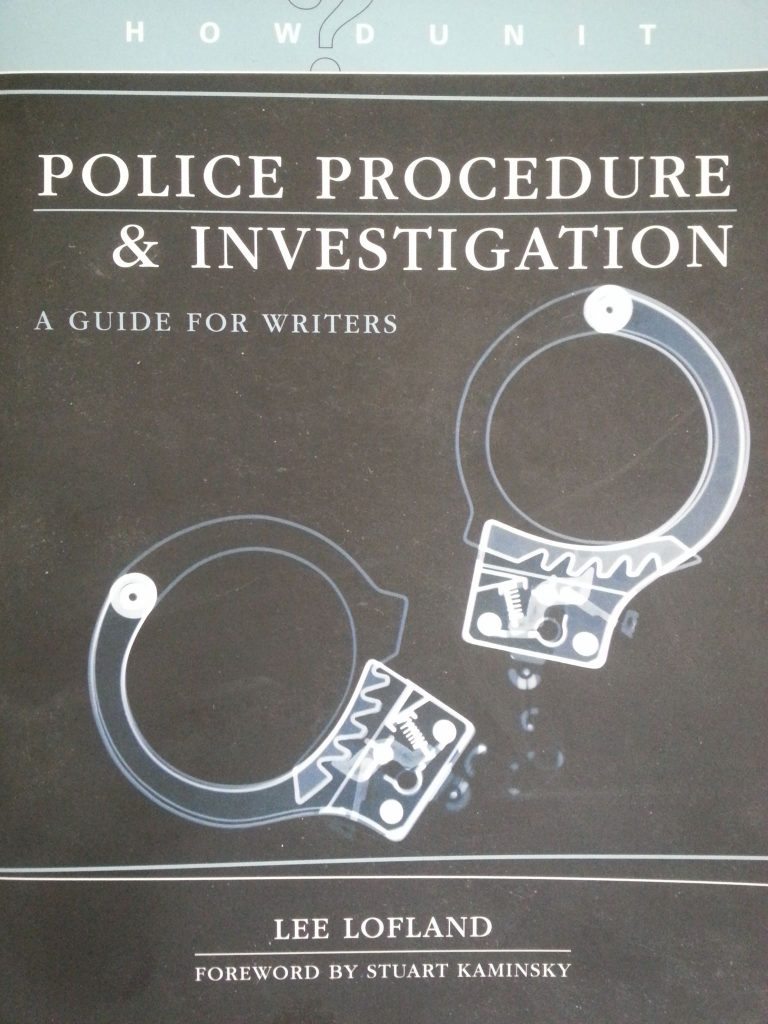Transferring DNA Evidence: 8 Things Your Protagonist Should NOT Do
Leading characters should be written as real people with real problems and real goals. They’re people a reader wants to care about. Protagonists are likeable and smart, yet flawed in some way.
Sure, the hero will win, we know that, and we love seeing them doing what they do to solve the murder du jour. But what should they NOT do while poking and prodding through crime scenes? Well, here’s a short list of eight things we shouldn’t see in your books.

Don’t touch!
1. Picking up the murder weapon at an already secure homicide scene is a no-no. First, investigators should be sure the weapon was photographed exactly as it was found. Next, when the time comes to move the firearm, the detective should use care to protect possible fingerprints, trace evidence, and DNA. Of course, if the scene is not secure and 100 people are still running through the area like crazed zombies, officers should immediately secure the weapon using whatever means available, if any, to prevent contamination and to avoid the possibility of becoming murder victim number two.
2. Don’t let your hero cover the body with things found at the crime scene (blankets, sheets, the living room rug) because doing so could transfer potential evidence from the covering to the body, or from the body to the covering. I promise, the dead guy doesn’t care that he’s lying on the floor in his birthday suit.
3. Don’t let TV cops blunder around inside your protagonist’s crime scene. Outsiders are apt to step on evidence, spill things, move evidence, bring things into the crime scene (fibers, etc.) that shouldn’t be there, and they always, always, always touch things.

A crime scene isn’t the place to have a conversation about going to Cape Cod on vacation while walking from room to room drinking a cup of coffee. This also isn’t the time for shyness. If necessary, have the hero use their best command presence and demand that looky-loo’s remain outside the perimeter.
4. Please don’t have your hero dig a bullet from the door casing and then immediately say, “Just as I suspected, the murder weapon is a 9mm SIG Sauer.” It’s darn near impossible to know the caliber of misshapen bullets/fragments merely by looking at them, and cops, or anyone else, certainly wouldn’t be able to guess which brand of gun fired it. The same is true about entrance and exit wounds. You can’t judge the caliber size merely by glancing at an wound in human flesh.
5. Revolvers do NOT automatically eject spent brass. If empty casings are found at the crime scene it’s likely because the shooter manually dumped them there, which would be highly unlikely. Semi-automatics and automatic weapons do automatically eject spent casings, but you won’t find them in a neat little pile beside the body. Normally, semi- and fully-automatic weapons eject brass a few feet away from the shooter, and they may bounce in several directions, depending upon the surface/item they strike—concrete floor, wood flooring, lamps, tables, carpeting, etc.

Inanimate objects cannot be robbed. Stealing from a home is burglary.
6. Robbers cannot rob a house. A robbery occurs when a bad guy forces someone—a person, not an inanimate object—to give him money/items. Breaking into an empty house and taking a TV or jewelry is burglary. The two are not synonymous. They are not the same! I’ll say it again, robbery and burglary are not the same.
7. Cordite. Need I address this again? Your hero won’t smell cordite because the stuff is no longer used in modern ammunition.
Now, let’s delve a bit deeper into a couple of the areas I mentioned in the above list of things a protagonist should not do. For instance, I highlighted the fact that detectives should NOT cover the body with any item found at the scene. I also detailed that people entering a crime scene could contaminate the area by bringing in trace evidence on their shoes, clothing, etc. Tertiary transfer, my good friends, is the reason why these things should never take place, and here’s why not.
8. Tertiary DNA Transfer – DNA can be accidentally transferred from one object to another. A good example could be the killer who shares an apartment with an unsuspecting friend. He returns home after murdering someone and then tosses his blood-spattered shirt into the washer along with his roommate’s clothing. The machine churns and spins through its wash cycles, an action that spreads the victim’s DNA throughout the load. Police later serve a search warrant on the home, seize the clothing, and discover the victim’s DNA on the roommate’s jeans. The innocent roommate is arrested for murder.

Tertiary Transfer of DNA Evidence
The same can occur with touch DNA. A man shares a towel with his wife and his DNA is subsequently transferred to her face and neck. Later, a stranger wearing gloves chokes the woman to death, transferring the husband’s DNA from the victim’s face to the killer’s gloves. The assailant removes the gloves and leaves them at the scene. Police confiscate the gloves, test them, and find the husband’s DNA. He is then charged for his wife’s death while the real killer is free to murder again.
The example above (the choking case) actually happened, and those of you who attended the Writers’ Police Academy session taught by DNA expert Dr. Dan Krane heard him speak of it. He was the expert who proved this was indeed possible and he testified to it in the groundbreaking case involving accused killer Dr. Dirk Grenadier.
By the way, I’ve been talking about tertiary transfer/secondary-transfer of DNA evidence for a few years now. In fact, I first wrote about it in my book on police procedure, but I don’t think everyone believed me.
Here’s what I wrote (page 170 – 171 of Police Procedure and Investigation).
“It’s actually quite easy to transfer DNA evidence. When evidence is transferred from a person to an item, it’s called a primary transfer of evidence. When evidence is transferred from one item to another, it’s called secondary transfer. Tertiary transfer occurs when the DNA that’s been transferred to a second item is again transferred to a third item.
DNA can also be transferred to people who then use that item, such as a towel that’s been used by someone else. DNA can even be transferred from one article of clothing to another in a clothes washer.
Evidence that’s been cross-contaminated will exhibit false results and could be used to convict the innocent and allow the guilty to go free.”
“In December 2012 a homeless man named Lukis Anderson was charged with the murder of Raveesh Kumra, a Silicon Valley multimillionaire, based on DNA evidence. The charge carried a possible death sentence. But Anderson was not guilty. He had a rock-solid alibi: drunk and nearly comatose, Anderson had been hospitalized—and under constant medical supervision—the night of the murder in November. Later his legal team learned his DNA made its way to the crime scene by way of the paramedics who had arrived at Kumra’s residence. They had treated Anderson earlier on the same day—inadvertently “planting” the evidence at the crime scene more than three hours later.” ~ by Peter Andrey Smith, Scientific American

Exciting News!

The Writers’ Police Academy is pleased to announce the June 2022 return to in-person, hands-on training at one of the country’s top law enforcement training academies. Registration for this action-packed, thrilling event often sells out quickly. Therefore, for the first time ever you’ll have a chance to secure your spot now. In addition, this offer includes a 5% discount off the 2022 registration fee.
Here’s all you have to do to take advantage of this incredible opportunity—sign up to attend 2021 MurderCon. It’s that simple!
Once you’ve registered for MurderCon, your 2022 WPA spot is automatically reserved at the specially discounted rate (5% discount off the 2022 rate).

Writers drive police vehicles in hot pursuit, then perform PIT maneuvers. THRILLING and HEART-POUNDING!
This offer applies retroactively to everyone who’s already registered to attend the 2021 MurderCon event!
Those of you who elected to rollover your Writers’ Police Academy registrations from the 2020 event that cancelled due to COVID, your spot is reserved for the 2022 WPA, at the 2020 rate.
To claim your discounted rate, you must complete a new registration form. The 2022 WPA registration opens in February. Details coming soon.
In the meantime, sign up to attend the 2021 MurderCon, the ultimate training event featuring incredibly detailed and cutting-edge workshops.

*MurderCon sessions, taught by some of the world’s leading experts, have never been available to writers, anywhere.






Nice explanation Lee!